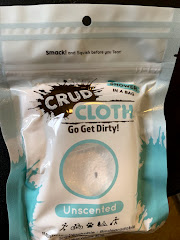Ask my fiancé and she'll confirm, I'm a sucker for a good bag. Tactically designed with lots of pockets and expandability and I'm throwing my money at the cash register. In the preparedness community there are several types of bags, and kits most 'preppers" herald to suit a variety of purposes. In this post I hope to cover and clarify a few of those kits along with their intended purposes from convenience to surviving disasters.
Detailing my adventures in preparedness, survivalism, outdoors-manship, and other life-related experiences. :) . Enjoy.
Wednesday, June 30, 2021
Preparedness Kits and Bags - A Few Examples
Wednesday, June 16, 2021
TEOTWAWKI Scenarios! Two Sides of the Coin
There are many TEOTWAWKI (The End Of The World As We Know It for those not quite as versed) scenarios each with varying degrees of survivability. As someone interested in writing an apocalyptic story someday, I've often pondered what the 'event' or 'events' I would utilize as the background for my own apocalyptic adventure series would entail. Some scenarios are horrifically dire and offer the barest chance (if any) of survivability - think The Road. Others are a little more survivable, but come with their own lasting effects or impressions that survivors have to deal with from there. Still, other scenarios would stage human survivors with a near-utopian environment within which to grow and evolve.
Below I explore the polar-opposite sides of the spectrum for TEOTWAWKI events along with the differences in outcome. Of course the outcome of TEOTWAWKI events is an analog scale with everything in between and, for the course of this mental exercise, I'm assuming these events are End of the World As We Know It, not the actual end of the physical world.
Common Threads
Major, Sudden Environmental Impact/Minor Initial Human Impact
Minor to Non-Existent Environmental Impact/ Major Human Impact
Final Musings
Sidebar..... Tribal Warfare
Wednesday, June 9, 2021
BattlBox Mission 76 Review
Okay, so I gotta be honest, I was going to cancel my BattlBox subscription after my last review, but I let that lapse and I ended up getting another one. Below is my review of Mission Brief 76, Basic edition.
Stuff
Crud Cloth
- Pros:
- Few beginner preppers worry themselves about hygiene when getting started in preparedness so a nice little compact way to clean and sanitize yourself and your gear is pretty clever. Toss this in any of your kits and you won't stink quite as much throughout the disruption.
- The 12"x12" washcloth in the package is washable and reusable so there's a dual purpose as a camp cloth, too.
- Cons:
- None that I can really think of other than there are options to get the Crud Cloth in other scents. The Crud Cloth that came in the box is unscented which is what I'd prefer in a disaster scenario if I'm washing my junk in the woods. The other scents (peppermint, tea tree, lavender, or citrus) may give you away or attract insects.
Lord and Field drink cozy
- MSRP: $24.99 (remember, it's genuine leather).
- Pros:
- It's genuine leather and very well made. VERY well made.
- It has the nice leather smell so when ever you take a drink of...whatever you're drinking, you get the bonus of a leather tinge.
- Cons:
- Despite being genuine leather, the price is violently high. If you're interested in this product, I suggest shopping around a bit.
- I rarely use cozies and even if I did the need for one during a disruptive event escapes me.
The FBKnife by Ganzo Knives
- MSRP: $26
- Pros:
- 440 steel
- One-hand open operation w/lock (close is two-handed, then, obviously).
- Built in belt/pocket clip.
- Wicked-sharp out of the box (no, I didn't cut myself).
- Over all the price is nice for the quality.
- Cons:
- It's made in China.
- No sheath, just a little draw string sack to keep it pretty, I guess.



















